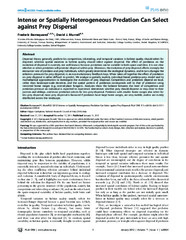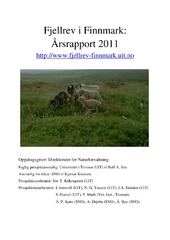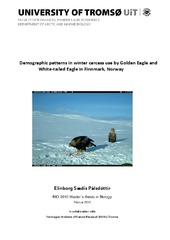Institutt for arktisk og marin biologi: Recent submissions
Now showing items 1881-1900 of 2049
-
Hatchery selection may depress the number of motile sperm but intensify selection for their swimming velocity in the Arctic charr
(Journal article; Tidsskriftartikkel; Peer reviewed, 2012)The ability of captive breeding programs to maintain genetic diversity and fitness has often been questioned. Recent studies suggest that fitness loss can be extremely rapid in various traits, but it is poorly known how captive breeding affects sperm quality and thus male fertility. We studied the potential effects of hatchery-induced selection on traits indicative of semen quality, in four generations ... -
Do the fastest sperm within an ejaculate swim faster in subordinate than in dominant males of Arctic char?
(Journal article; Tidsskriftartikkel; Peer reviewed, 2006)Theoretical models predict that subordinate males should have higher sperm velocity to compensate for their disadvantaged mating role and because they experience sperm competition more frequently than dominant males. Differences in mean velocity between sperm of dominants and subordinates in the predicted direction are also documented for a few species, including the Arctic char, Salvelinus alpinus ... -
Sympatric diversification as influenced by ecological opportunity and historical contingency in a young species lineage of whitefish
(Journal article; Tidsskriftartikkel; Peer reviewed, 2010)In adaptive radiations, ecological opportunity (i.e. niche availability) is considered to be an important driver to increase phenotypic variation, but diversity may also be constrained by historical factors related to colonization events. How do ecological opportunity and post-glacial colonization history affect the phenotypic diversity in a young species lineage? We quantified phenotypic diversity ... -
Intense or Spatially Heterogeneous Predation Can Select against Prey Dispersal
(Journal article; Tidsskriftartikkel; Peer reviewed, 2012)Dispersal theory generally predicts kin competition, inbreeding, and temporal variation in habitat quality should select for dispersal, whereas spatial variation in habitat quality should select against dispersal. The effect of predation on the evolution of dispersal is currently not well-known: because predation can be variable in both space and time, it is not clear whether or when predation will ... -
Invader population speeds up life history during colonization
(Journal article; Tidsskriftartikkel; Peer reviewed, 2012)We explore the long-term developments in population biology and life history during the invasion and establishment of the fish species vendace Coregonus albula in a subarctic watercourse by comparing life-history traits and molecular genetic estimates between the source and the colonist population. The two populations exhibited highly contrasting life-history strategies. Relative to the source ... -
The amphipod scavenging guild in two Arctic fjords : seasonal variations, abundance and trophic interactions
(Journal article; Tidsskriftartikkel; Peer reviewed, 2012)Scavenging amphipods are important for the circulation and dispersal of organic material in the marine environment. Despite their dominance in the scavenging guild and importance in the food web, little is known about Arctic amphipods and their feeding preferences. We studied the amphipod scavenging guild using baited traps for one full year to increase our understanding of its seasonal variations. ... -
Metagenomics of the Svalbard Reindeer Rumen Microbiome Reveals Abundance of Polysaccharide Utilization Loci
(Journal article; Tidsskriftartikkel; Peer reviewed, 2012)Lignocellulosic biomass remains a largely untapped source of renewable energy predominantly due to its recalcitrance and an incomplete understanding of how this is overcome in nature. We present here a compositional and comparative analysis of metagenomic data pertaining to a natural biomass-converting ecosystem adapted to austere arctic nutritional conditions, namely the rumen microbiome of Svalbard ... -
Assessing the causes of breeding failure among the rough-legged buzzard (Buteo lagopus) during the nestling period
(Journal article; Tidsskriftartikkel; Peer reviewed, 2012)When food becomes scarce, the youngest nestlings in facultatively siblicidal raptor species typically die and such events are usually attributed to siblicide. Here we present results from an investigation in the Arctic tundra, in which rough-legged buzzard (Buteo lagopus) breeding success was monitored with regular visits to nests and time-lapse cameras that continuously recorded the activity of ... -
Lagesilda i Pasvikvassdraget : langtidseffekter av en biologisk invasjon
(Research report; Forskningsrapport, 2012)Pasvikvassdraget har siden 1991 vært gjenstand for omfattende økologiske studier i regi av Ferskvannsøkologisk faggruppe ved Universitetet i Tromsø. Undersøkelsene har særlig vært rettet mot å undersøke effektene av at lagesilda, en fremmed fiskeart for Nord-Norge, kom inn i vassdraget på slutten av 1980-tallet. For å få en grundig forståelse av økologien i vassdraget har studiene også omfattet ... -
Lipid sac area as a proxy for individual lipid content of arctic calanoid copepods
(Journal article; Tidsskriftartikkel; Peer reviewed, 2010)We present an accurate, fast, simple and non-destructive photographic method to estimate wax ester and lipid content in single individuals of the calanoid copepod genus Calanus and test this method against gas-chromatographic lipid measurements. -
Toward understanding the effect of top predators on ecosystems
(Journal article; Tidsskriftartikkel, 2009)To what extent top predators - carnivores at the top of food chains - drive or just respond to ecosystem dynamics is a central, but partially unresolved, question in ecology. In this report, we highlight how different research approaches employed in aquatic and terrestrial ecology may have a bearing on how the role of top predators in ecosystems is perceived. -
Declining willow ptarmigan populations : the role of habitat structure and community dynamics
(Journal article; Tidsskriftartikkel; Peer reviewed, 2011)The recent range contractions and population declines of many grouse species worldwide have been attributed to loss and fragmentation of their habitats, although the empirical evidence for the actual drivers is often weak. In case of the willow ptarmigan Lagopus lagopus in Fennoscandia, ungulate overbrowsing of willows has been hypothesized to exert such negative habitat-related impacts. Moreover, ... -
Whirly proteins as communicators between plant organelles and the nucleus?
(Journal article; Tidsskriftartikkel; Peer reviewed, 2009)Whirly proteins belong to a small family of proteins with a characteristic secondary structure and a conserved DNA binding domain that is found mainly in angiosperms. At least one member of the Whirly protein family, Whirly1, is dually targeted to the nucleus and to the chloroplasts and it was shown that apart from its initially described function as a transcriptional regulator of nuclear disease ... -
Fjellrev i Finnmark : årsrapport 2011
(Research report; Forskningsrapport, 2012) -
Demographic patterns in winter carcass use by Golden Eagle and White-tailed Eagle in Finnmark, Norway
(Master thesis; Mastergradsoppgave, 2012-02)The carcass use of juveniles, subadults and adults of the two eagle species in Norway, the White-tailed Eagle (Haliaeetus albicilla) and the Golden Eagle (Aquila chrysaetos) was studied in Finnmark, the northernmost county of Norway for two winters, in 2009 and 2010. Artificial carrion was laid out as bait on four peninsulas, along with automatic digital cameras which took picture on 5-15 minutes ... -
Rapid, landscape scale responses in riparian tundra vegetation to exclusion of small and large mammalian herbivores
(Journal article; Tidsskriftartikkel; Peer reviewed, 2011)Productive tundra plant communities composed of a variety of fast growing herbaceous and woody plants are likely to attract mammalian herbivores. Such vegetation is likely to respond to different-sized herbivores more rapidly than currently acknowledged from the tundra. Accentuated by currently changing populations of arctic mammals there is a need to understand impacts of different-sized herbivores ... -
Plastic reproductive allocation as a buffer against environmental stochasticity : linking life history and population dynamics to climate
(Journal article; Tidsskriftartikkel; Peer reviewed, 2011)Empirical work suggest that long-lived organisms have adopted risk sensitive reproductive strategies where individuals trade the amount of resources spent on reproduction versus survival according to expected future environmental conditions. Earlier studies also suggest that climate affects population dynamics both directly by affecting population vital rates and indirectly through long-term changes ... -
Spawning behaviour of Arctic charr (Salvelinus alpinus) : risk of sperm competition and timing of milt release for sneaker and dominant males
(Journal article; Tidsskriftartikkel; Peer reviewed, 2011)A mismatch in timing between the release of male and female gametes in external fertilizers may lead to failed fertilization or, under sperm competition, reduced paternity. To quantify the actual synchrony of gamete release and the level of sperm competition we placed video cameras on two spawning grounds of a naturally spawning population of Arctic charr ( Salvelinus alpinus). Females release eggs ... -
Red fox takeover of arctic fox breeding den : an observation from Yamal Peninsula, Russia
(Journal article; Tidsskriftartikkel; Peer reviewed, 2011)Here, we report from the first direct observation of a red fox (Vulpes vulpes) intrusion on an arctic fox (Vulpes lagopus) breeding den from the southern Arctic tundra of Yamal Peninsula, Russia in 2007. At the same time, as a current range retraction of the original inhabitant of the circumpolar tundra zone the arctic fox is going on, the red fox is expanding their range from the south into arctic ... -
Shrub expansion in tundra ecosystems : dynamics, impacts and research priorities
(Journal article; Tidsskriftartikkel; Peer reviewed, 2011)Recent research using repeat photography, long-term ecological monitoring and dendrochronology has documented shrub expansion in arctic, high-latitude and alpine tundra ecosystems. Here, we (1) synthesize these findings, (2) present a conceptual framework that identifies mechanisms and constraints on shrub increase, (3) explore causes, feedbacks and implications of the increased shrub cover in tundra ...


 English
English norsk
norsk


















